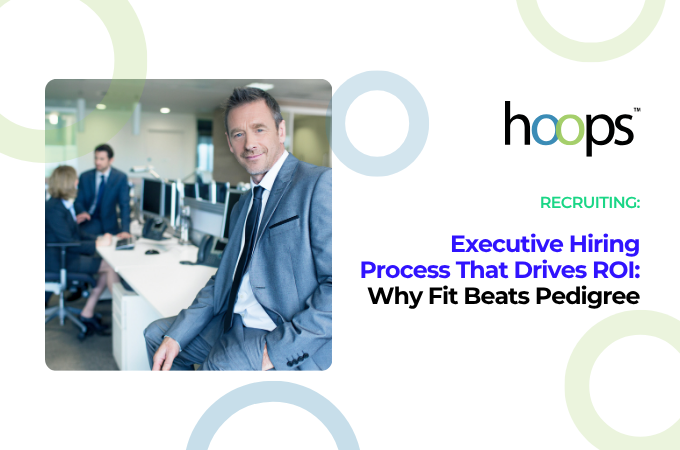You’re Not Just Hiring an Executive. You’re Hiring Your Next 5+ Years.
One great executive hire can realign your org chart, accelerate revenue, and unlock growth across every department. One wrong hire? It quietly unravels everything.
When a leader lacks fit—or arrives without clear expectations, stakeholder alignment, or cultural buy-in—it doesn’t just disrupt one department. It slows your entire company down.
In today’s market, executive hiring is a competitive lever, so long as you have the right executive hiring process.
Poor leadership can cost up to 7% of annual revenue in mature companies—and as much as 20x an executive’s total compensation in high-growth or PE-backed firms (SeedWorld, 2025). That kind of exposure demands a smarter, more strategic approach to your executive hiring process.
The New Stakes of Executive Hiring
Executive hiring process cycles are long. High-stakes. Costly. And often flawed from the start.
Here’s what the current landscape looks like:
- Executive turnover is climbing: CEO turnover increased 13% from 2023 to 2024 (SHRM, 2025)
- Executive turnover risk is rising: 55% of C-suite leaders say they’re likely to leave within two years (Gartner, 2025)
- Only 40% of leaders feel ready for the challenges ahead—and just 12% of companies rate their leadership pipeline as strong (DDI, 2025)
- Hybrid leadership is now the norm: 70% of executives work in hybrid models, demanding new leadership capabilities (Gartner, 2025)
- C-suite hiring is slower than ever: Executive searches now take 6–9 months on average—significantly longer than pre-pandemic timelines (AESC, 2024)
In short: the stakes are higher, the landscape is shifting, and the margin for error is shrinking.
Yet despite this, most companies still rely on pedigree, intuition, or outdated interview playbooks when hiring for their most critical roles.
That’s not strategy. That’s risk.
The Real Reason Executive Hiring Fails
Your executive hiring process doesn’t usually fail because candidates weren’t skilled enough or didn’t have the right title.
It fails because companies often hire for what sounds good on paper—without a clear plan for what success in the role actually looks like.
Sometimes the process is too rushed. Other times, it’s driven by instinct or internal politics instead of long-term business goals. And too often, the team isn’t aligned on what the organization really needs in its next leader.
When there’s no structured process, no shared definition of success, and no alignment around outcomes, even highly credentialed hires can miss the mark.
The good news? That’s fixable—with an executive hiring process built to match your company’s stage, strategy, and values.
The 5-Part Executive Hiring Process Built for Business Impact
At Hoops, we’ve developed a proven hiring approach that helps companies build high-performing teams—not by relying on luck or resumes, but by aligning leadership to business needs, culture, and future growth plans.
Here’s how to structure an executive hiring process that drives real Return on People Investment (ROPI):
Step 1: Define What Success Looks Like
Don’t start with the job description. Start with the outcome.
What will success look like at 6, 12, and 24 months? What challenges will this person inherit? What transformation must they lead?
Create a Leadership Success Profile that includes:
- Mission-critical KPIs tied to revenue, culture, or innovation
- Stakeholder dynamics (Who must they influence?)
- Leadership style that complements your existing team
- Red flags to avoid (from past hiring missteps)
Then translate your Leadership Success Profile into a role-specific scorecard—a practical, measurable tool that ensures everyone evaluating candidates is aligned on what truly matters: performance, impact, and cultural fit.
Here are a few questions to get you started:
- What are the top 3 business priorities this leader must own?
- What does “working well” and “not working out” look like?
- What will this hire enable others to do better or faster?
Step 2: Source Beyond the Job Boards
The best candidates aren’t actively applying. They’re leading—heads down in a role where they’re already making an impact—but may be ready for something more.
Modern sourcing should:
- Combine AI + human strategy to surface under-the-radar talent
- Tap into passive talent through targeted outreach and engagement strategies based on candidate behavior signals
- Identify and engage high-performers at competitor organizations—not just those responding to job ads
- Look beyond title-matching to identify trajectory, adaptability, and future potential
This is where most search firms fall short—they recycle résumés. But elite candidates don’t respond to generic outreach. They respond to well-framed opportunity, informed by data and strategy.
Step 3: Assess for Strategic Fit
Once candidates are in play, the real work begins.
Resumes tell you where they’ve been. Your process should tell you where they can take you.
Use a combination of:
- Scenario-based interviews tied to your leadership success profile
- Role-specific scorecard for cross-functional consistency
- Conversational interviews that explore how candidates think—not just what they’ve done
But don’t stop at qualifications. Assess whether their leadership strengths and decision-making style match the strategic phase your company is in.
Are you in rapid scale mode? Post-merger integration? Stabilizing after a pivot? The right leader for one phase may not thrive in another. Strategic fit means aligning a candidate’s leadership mindset with the specific growth challenges ahead, not just their ability to manage a team or hit targets.
Step 4: Engage Stakeholders the Right Way
By the time some hiring teams align internally, the best candidates have moved on.
To streamline without sacrificing quality:
- Involve key stakeholders early (board, peers, finance)
- Pre-align on compensation guardrails and offer strategy
- Set clear internal SLAs to avoid dragging out decisions
According to the National Association of Corporate Directors, 89% of C-suite hires now include direct board involvement. If your process doesn’t plan for this, it creates friction—or worse, delays that cost you the candidate.
Step 5: Close with Confidence
Final offers should never be a surprise. By this point, you should:
- Know what the candidate values (bonuses? title? impact? hybrid flexibility?)
- Have validated market-competitive comp via recent benchmarks
- Present onboarding expectations and 90-day milestones upfront
Just like any new hire, top execs need a runway to thrive. Set clear expectations, show the roadmap, and offer the support system behind it. You’ll reduce offer declines and increase long-term retention.
Real-World Example: Why Fit Beats Pedigree
A growing healthcare organization had been stuck in an executive search cycle—sifting through candidates with impressive titles, yet no real traction. On paper, everything looked great. In practice? Progress had stalled.
They didn’t need another pedigree resume. They needed the right leadership and growth-stage fit.
That’s when they stepped back and asked a better set of questions: What does success actually look like in this role? What specific outcomes are tied to this hire? What kind of leader has the experience and mindset to make that happen?
We helped them anchor their executive hiring process to business goals—defining clear success criteria, aligning stakeholders, and identifying a leader who could deliver measurable impact. Within one quarter, they saw meaningful change.
Because when you lead with strategic fit—not surface-level credentials—you put the right person in the right role to move your business forward.
Final Thoughts: Your Process Is the Advantage
The best executive hiring processes aren’t just about finding someone good. They’re about finding the right leader, for the right stage, to deliver the right impact.
You already know the importance of strong leadership. But the process you use to find and evaluate that leadership? That’s where the real leverage is.
When you dial in your executive hiring process, you:
- Reduce turnover
- Increase ROI
- Align your people strategy with your business goals
- And free up time to focus on scaling—because the right leaders scale with you
At Hoops, we’ve built executive hiring processes for scaling businesses, PE-backed ventures, and founder-led teams ready to level up. We believe in giving away the strategy—because great teams change lives.
Ready to build yours? Learn how Hoops Executive Search finds proven, high-impact leaders—without the bloated fees:
👉 Learn more about Hoops’ Executive Search services
Build Your Winning Team. Hire and Scale Talent.







